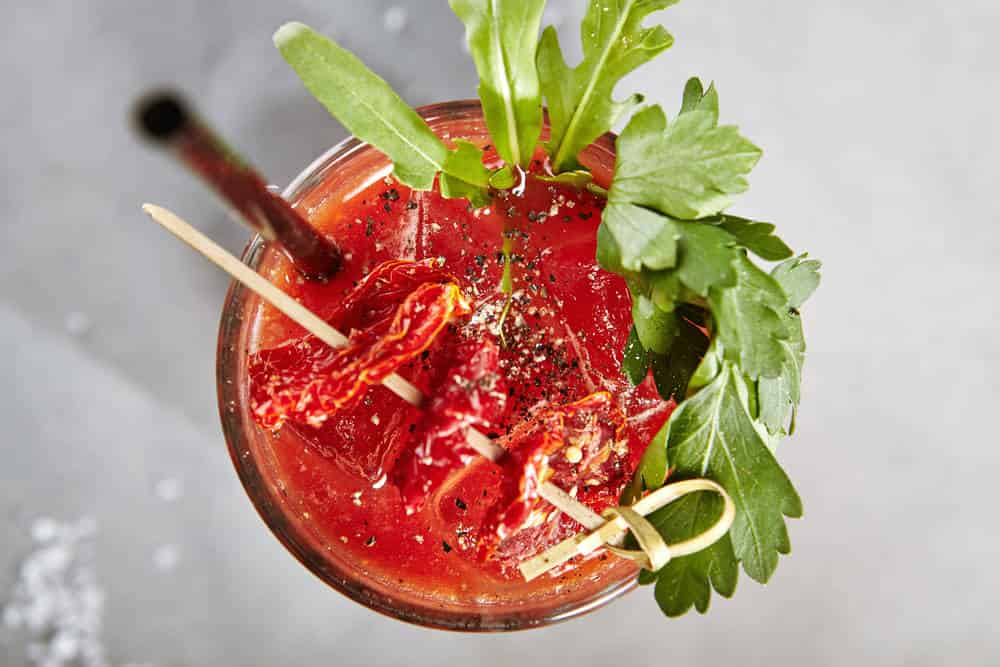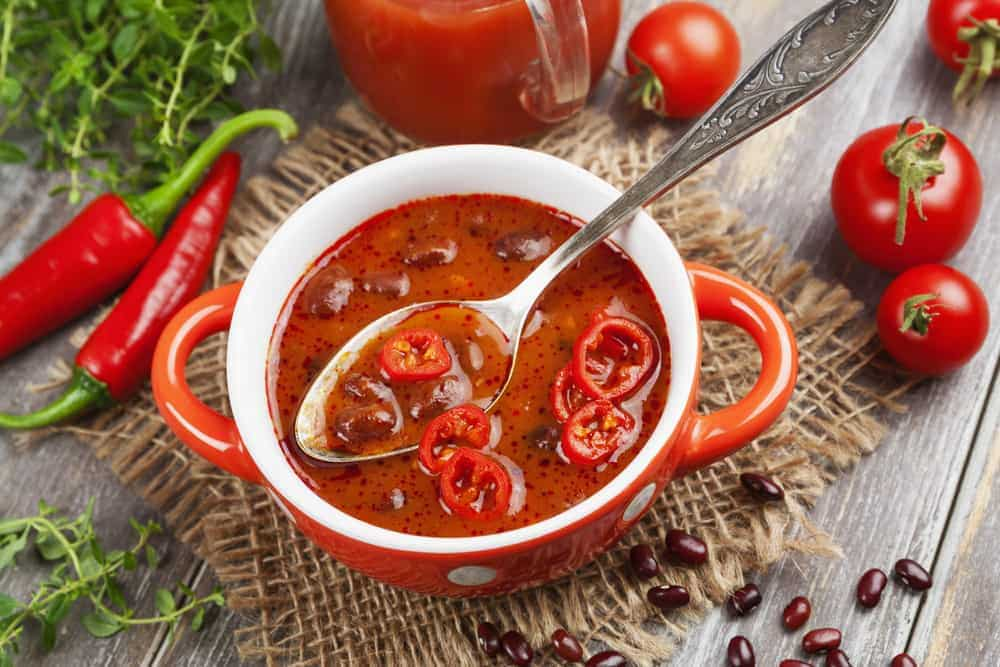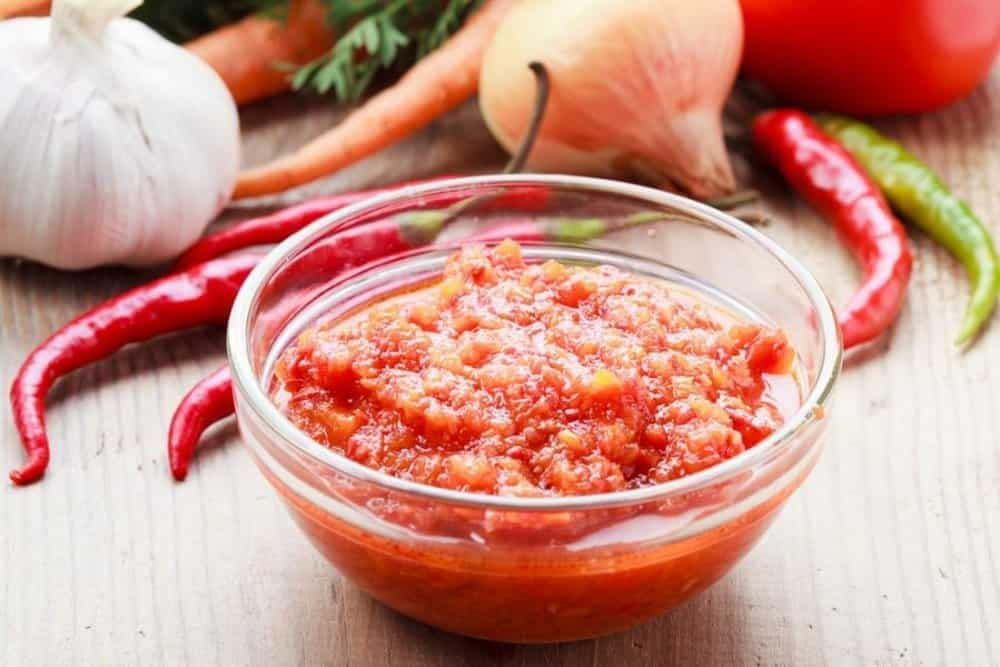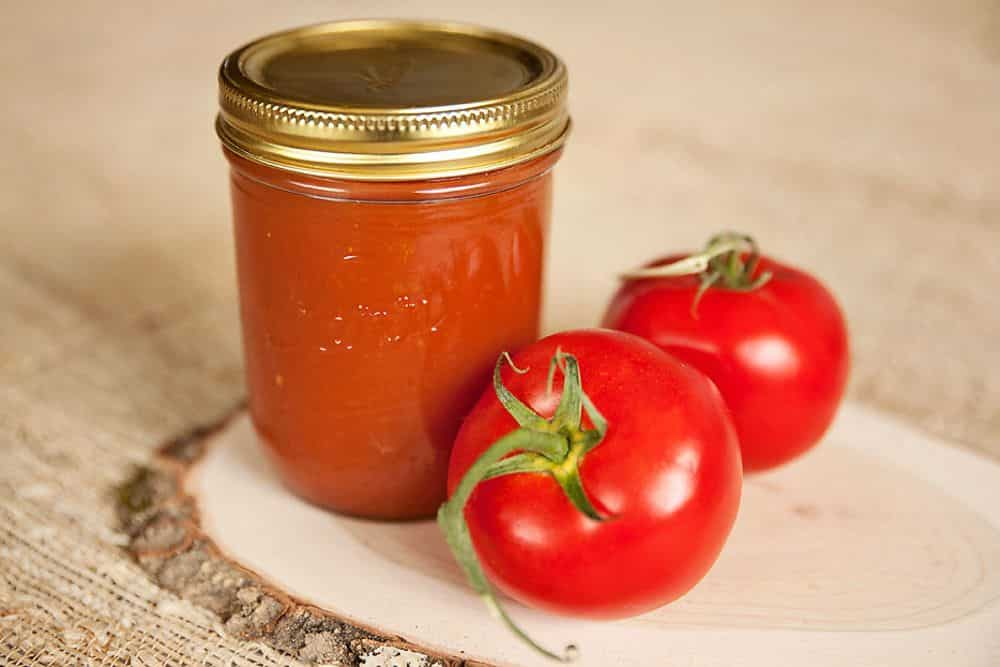In some desserts such as chili, try adding a little bit of tomato puree or tomato paste that really makes the dishes thicker and more delicious. If you want to surprise your family, try this special recipe.
The dish known as “chili with meat” is a spicy stew that often includes chili peppers (occasionally in the form of chili powder), tomatoes, meat (typically beef), and either pinto beans or kidney beans. Garlic, onions, and cumin are among additional seasonings that may be used. The dish is said to have originated in either the northern part of Mexico or southern Texas.

Different regions and individuals tend to prefer various cuts of meat and combinations of other components. Aficionados often argue about recipes, with some maintaining that the term “chili” refers exclusively to the most fundamental version of the dish, which does not include beans or tomatoes.
In competitive cooking events, chili con carne is often served as the main dish. However, it can also be used as a condiment, a side dish, or as an ingredient in other dishes, such as soups or salsas.
A substantial soup or stew, chili is a dish that is truly one of a kind. There are a wide variety of recipes, each with its own distinctive combination of components.
Since it would appear that every mother has her own recipe for chili, there is a good probability that the chili that you are familiar with and enjoy tastes a little bit different than the chili that other mothers make.
There is one thing on which everyone can reach a consensus, and that is the fact that it is one of the most popular comfort meals in the United States. In fact, the fourth Thursday of February has been declared National Chili Day.
What Exactly Is a Chili?
The question now is: where does chili originate? Many historians believe that this dish was first created in Texas and was influenced by the Spanish, Mexican, and Native Americans who were all living there at the time. Although it is not certain exactly when or how the chili originated, many historians believe that this dish was first created in Texas.
At the time, it was a stew made from beef and chili peppers and was known as “chili con carne,” which translates to “chili peppers with meat” in Spanish. Chili con carne was a popular dish in Mexico.

It was a standout dish at the World’s Columbian Exposition in Chicago in 1893 and gained popularity among cowboys and frontier settlers during that same year.
During this historical period, chili was particularly popular in San Antonio, Texas, and the recipe that originated in this city was considered something of a standard up until the point when chili began to gain appeal across the country.
So, what exactly does it taste like to eat chili? In modern times, the people of Texas have come to the conclusion that chili should only have chili peppers, beef, and seasonings. However, many contemporary recipes also call for the addition of beans, vegetables, and sometimes even noodles. You can find recipes with a wide variety of ground meat at chili cook-offs held all around the United States, including:
Beef \sSausage
Turkey \sVenison \sChicken
Other recipes are entirely plant-based or vegan, and they call for a variety of vegetables as well as a selection of legumes.
Depending on the combination of spices that are used, chili can have a flavor that ranges from not very spicy to quite spicy.
How is it that chili is made?
As was noted, there are an apparently infinite number of ways to prepare chili depending on the individual’s preferences. On the other hand, ground beef and beans constitute a well-liked variant that can be discovered in a great many kitchens and informal dining establishments across the United States.

The traditional method for preparing chili utilizes a sizable soup pot or a Dutch oven. Sautéing diced veggies like onions, bell peppers, and garlic results in the vegetables achieving a softer consistency.
The next step is to add spices such as cumin, oregano, and chili powder; however, if you want to make chili at home, you may also buy spice packets that already have the spices blended together. After that, ground beef is added to the mixture, and it is cooked completely while being combined with the veggies and spices.
Since chili is a kind of soup, the next step is to add the liquids. Tomatoes, either fresh or canned, are diced and added, along with water or even stock, depending on the recipe. Before the heat is reduced to allow the chili to simmer, additional spices such as salt and pepper are typically added.
Chili can be allowed to simmer for anything from thirty minutes to a couple of hours, depending on the recipe and the type of pot that is used.
Is chili good for you?
Because there are so many different ways to make chili, some of the recipes are more nutritious than others. Because it contains components from numerous important food groups, chili is generally regarded as a food that is beneficial to one’s health.
If you want to make a bowl of beef chili that is lower in fat and calories, consider lean ground beef. Cutting back on the amount of fat in your meat is beneficial for the health of your heart and can reduce the likelihood that you will acquire diabetes.

Try ground turkey or chicken instead of ground beef because turkey and chicken are both lower in fat than beef. For an alternative that still has the texture of meat but is suitable for vegetarians, bulgur wheat or barley can be used.
Beans are an additional essential component of chili. The three most common bean varieties found in chili recipes are kidney, black, and pinto beans; however, you are free to experiment with other bean varieties to find out which one suits your tastes best.
The serving size of one cup of beans has 15 grams of protein, 15 grams of fiber, and vital elements such as folate and potassium. These beans are considered to be particularly nutritious.
People who consume beans on a daily basis tend to have healthier blood pressure and cholesterol readings, as well as more consistent blood sugar and insulin levels.
Since beans are an excellent source of lean protein, eating them regularly can also assist you in keeping a healthy weight. Because they are so beneficial to your health, it is recommended that you consume three servings of legumes on a daily basis.
Tomatoes and the other vegetables that go into making chili can offer a variety of additional benefits to your health. The inclusion of additional veggies results in an increase in the total amount of antioxidants and fiber, in addition to the myriad of nutrients that are provided by a wide variety of vegetables.
Consider including some or all of the following veggies in your next bowl of chili, in addition to tomatoes and peppers:
Pumpkin \sCarrots
Toadstools Sweet potatoes Parsnips Celery
Chili: A Look at Its Nutrient Profile
Even though there are numerous methods for cooking chili, the following is an example of the nutritional information that you can anticipate receiving if you were to order a bowl of the dish at a casual restaurant.

There are 157 calories, 9.8 grams of fat, and 12.6 grams of protein in a dish of chili that is made with meat and beans that weighs 100 grams.
Chili is not considered to be a meal that is low in fat; nevertheless, it is believed to be low in calories and delivers an excellent dose of protein due to the meat and beans that are included in its ingredients.
A portion of chili has a reasonable amount of carbs, sugar, and salt for its size. If you’re trying to decide what to have to eat in a restaurant, getting a bowl of chili is a fantastic choice because of all of these different factors together.
A Step-by-Step Guide to Making Chili With Tomato Puree
Chili is a one-pot dish that, like soup and stew, can have an infinite number of different varieties. Chicken, mushrooms, and zucchini are a bit more out of the ordinary than ground beef, steak, pork, corn, kidney beans, bell peppers, hot peppers, onions, tomatoes, garlic, cumin, oregano, brown sugar, and chili powder.
These components may be found in many different recipes for chili. A pot of chili made using tomato puree, which is a thick and strong concentration made from tomatoes, has a flavor that is bright and spicy and goes well with both ground beef and beans. This easy meal, which can be prepared in fewer than thirty minutes and serves four people, includes it as one of the primary flavoring components.
Step 1
Remove the onion’s skin and cut it up. Set the saucepan with the onion and ground beef over medium heat, and stir it often while cooking it until the beef has browned and the onion has become transparent. Remove any surplus fat from the dish.
Step 2 Place a stock pot or Dutch oven over medium heat and add the beef and onion to the pot. Mix in a complete can of tomato paste about 6 ounces.
After you have done so three times, pour the water from the can into the cooking pot. The chili powder, cumin, salt, black pepper, and brown sugar should all be added at this point.
Step 3 Empty the kidney beans into a colander so that they may drain and be thoroughly rinsed. Put them into the saucepan. Bring the chili to a boil, then lower the heat, cover it, and let it simmer for about 20 minutes, stirring it once or twice during the cooking process.

Step 4
Taste before serving. Add extra chili powder and cumin if you want the chili to have a higher level of heat. If you’d like, you can finish off each bowl by adding a sprinkling of shredded cheese and a blob of sour cream on top.
Things That Are Necessary To You
Bladed instrument
Board for cutting on
Small onion
1.05 kg of lean ground beef
Medium saucepan
Wooden spoon
Dutch oven or stockpot made of nonreactive material
a can of tomato paste weighing 6 ounces
Can opener
Measuring spoons
2 tsp. chili powder
1 tsp. salt
1/2 tsp. cumin
1/4 tsp. black pepper
2 tablespoons of dark brown sugar
16 oz. can kidney beans
Colander
Combination of shredded cheeses (optional)
Cream fraiche (optional)

Tip
Cooking using aluminum or copper cookware is reactive, which means that the materials react chemically with some foods, notably acidic components such as tomatoes and tomato paste, to produce a metallic flavor in the dish.
This can give the meal an unpleasant aftertaste. When preparing and serving tomato-based chili, it is crucial to use cookware that is non-reactive and won’t contact with acidic ingredients. Cookware made of stainless steel, enamel, clay, or glass is non-reactive and won’t interact with acidic ingredients.

Your comment submitted.